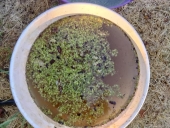Hi everyone!
I am a single middle aged person in a large Southern California
city.
Plants,
permaculture and etc is a very strong interest of mine, although due to my full time career I can't dedicate endless amounts of time to it.
My housemate volunteers himself to help with manual labor some of the time...but he's more of a tech guy....so designing the space and growing things is essentially all up to me.
Last spring/summer (2019) I decided I wanted a little
pond in my small (30'x50') urban backyard.
I didn't want an outdoor aquarium, run with filtration and electricity and chemicals; I wanted a naturally balanced
pond.
I wanted it to be attractive, available for the birds and insects (and possums); and I wanted it to be an extra
water source in case the urban supply ever cut out.
Suffice it to say it was a heck of a lot of work to create. Digging, getting the rocks and pebbles and etc...
Then, it was utterly gorgeous for six weeks until the
local raccoons discovered it, had their way with it and turned it into a muddy disaster hole.
It was around that time that I learned about the wicked parasites and diseases they carry. I had to go out of town last August, and I didn't want to leave my housemate with a diseased mudhole, so I drained it.
It's been like this ever since.
I was about to resurrect it, but I never did get a good raccoon barrier up.
A cover or an electrified
fence just seemed so ungainly and unsightly.
I had the idea to line the first shelf with stiff little pokey wires (like the ones on those landscaping flags) sticking up out of
concrete "rocks", so that they would have nowhere to step down and put their little paws in the pond. The wires would be stuck into heavy cement rocks so that they couldn't drag them out of the way. I haven't done this
project because it seems costly and time consuming, without any real guarantees of working.
Additionally, I was never really satisfied with the EPDM pond liner design. I didn't like the possibility of puncture, its tendency to reveal itself as the rocks slipped, and the fact that you have to surround the pond with all kinds of rocks to weigh down the lip of the liner. And again, the rocks would slip and you'd have this ugly black rubber sticking out. Not a very durable solution, really.
So now I have this big old hole that we dug by hand.
I'n not sure what to do with it.
In the winter, it gets essentially no sun (it's on the north side of my house, and I'm in northern hemisphere).
In the summer it gets a bunch of sun. It has a sailshade over it (for algae control) but it still gets some sun that angles in under and around part of the sailshade.
So of course I'd love a pond; but I'm wary of the labor and very wary of the potential for disease vectoring.
We did manage to avoid mosquito larvae by means of mosquito dunks and a few dragonfly larvae.
Here are my thoughts for the space--please add to these, or suggest a totally new idea!
1. I could fill in the hole and use the space for my baby plants.
That would require leveling all the nearby soil, which has some little slopes... by pushing the excess dirt into the hole.
Again, lots of physical labor, oh and the soil has some lead contamination, thank you older urban neighborhood.
All the labor we've done developing it, would be lost--but then, I don't want to fall victim to the "sunk costs" fallacy (hahaha! sunk!)
2. I could use quickcrete and seal up the bottom of the existing space, and make a pond that way.
That way, no raccoon puncture vulnerability. And no hassle with the lip of the liner or the sliding rocks revealing ugly black liner.
However, I'd probably have to devise some kind of a filter. I'm still a bit afraid of the labor and the potential disease vectoring.
3. I don't know! Argh! What have I gotten myself into? My enthusiasm and desire often outstrip my time,
energy, knowledge and ability to do research.
Thank you so much for your thoughts!

















